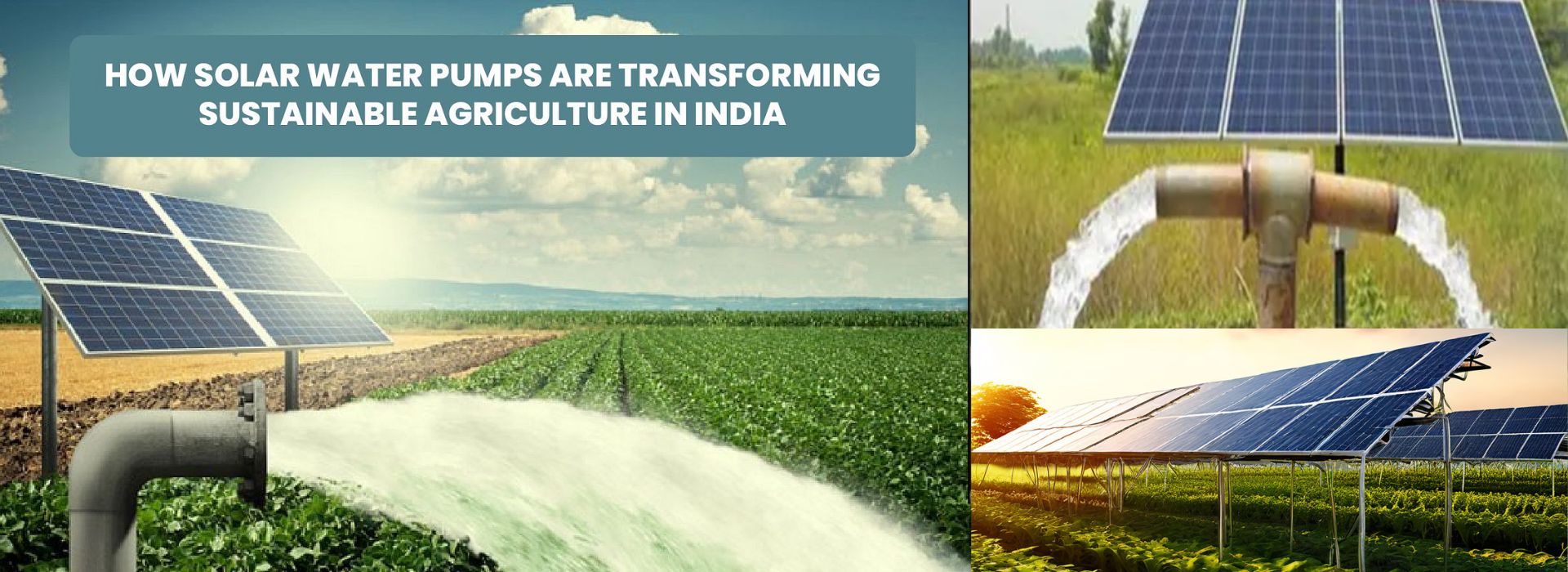Solar Irrigation Systems: The Future of Efficient and Sustainable Farming in India
October 23, 2024Solar
Irrigation Systems: The Future of Efficient and Sustainable Farming in India
India’s
agricultural sector, the backbone of the country’s economy, has long been
challenged by erratic rainfall, depleting groundwater levels, and rising energy
costs. In response to these challenges, solar irrigation systems have emerged
as a sustainable and efficient solution for modern farming. By harnessing the
power of the sun, farmers can irrigate their crops with minimal environmental
impact, significantly reducing their dependency on costly diesel or electric
pumps.
In
this blog, we’ll explore the benefits of solar irrigation systems, how they
work, and their potential to revolutionize farming in India.
1.
What is a Solar Irrigation System?
A
solar irrigation system uses solar panels to convert sunlight into
electricity, which powers water pumps that draw water from rivers, lakes,
ponds, or groundwater sources for irrigation. These systems can be used for
various methods of irrigation, including drip, sprinkler, and flood irrigation.
The
key components of a solar irrigation system include:
- Solar Panels: These capture sunlight and convert it
into electricity.
- Inverter: Converts the direct current (DC) from
the solar panels into alternating current (AC) that powers the pump.
- Water Pump: Draws water from the source and
delivers it to the fields.
- Water
Storage: Some
systems incorporate storage tanks to hold excess water, ensuring supply
during cloudy days or nighttime.
Solar
irrigation is not only environmentally friendly but also reduces operational
costs for farmers, offering a much-needed solution in regions where energy
access is unreliable or expensive.
2.
Benefits of Solar Irrigation Systems for Indian Farmers
1.
Cost-Effective Irrigation
Traditional
irrigation methods often rely on diesel or electricity-powered pumps, which can
be expensive and subject to price fluctuations. Solar irrigation, on the other
hand, has minimal ongoing costs after the initial setup, as sunlight is a free
and renewable resource. This makes it an ideal solution for small and marginal
farmers who may not have access to reliable electricity.
- Zero Fuel
Costs: Solar irrigation eliminates the
need for diesel or electricity, reducing farmers’ operational expenses.
- Long-Term
Savings: Although
the initial investment in solar panels and pumps can be higher, the system
pays for itself over time with significant savings in fuel and electricity
costs.
2.
Sustainable and Environmentally Friendly
Solar
irrigation is a clean energy solution that reduces the carbon footprint of
agriculture. By relying on solar power, farmers can reduce greenhouse gas
emissions associated with diesel pumps, contributing to a greener and more
sustainable agricultural sector.
- Reduces
Pollution:
Diesel-powered pumps emit harmful pollutants, while solar irrigation
systems produce zero emissions.
- Supports
Water Conservation: When
paired with efficient irrigation methods like drip or sprinkler systems,
solar pumps can optimize water usage, reducing waste and preserving
groundwater resources.
3.
Reliable Energy Source
India’s
rural farmers often face irregular electricity supply, especially in remote
areas. Solar irrigation provides a reliable and uninterrupted energy source, as
it functions independently of the grid and works efficiently even during power
outages.
- Energy
Independence: Farmers
are no longer reliant on inconsistent electricity supplies or costly
diesel, giving them greater control over their irrigation schedules.
- Increased
Productivity: Reliable
irrigation allows farmers to water their crops on time, leading to higher
yields and better crop quality.
4.
Low Maintenance and Durable
Solar
irrigation systems require minimal maintenance and have a long lifespan,
typically lasting 20-25 years. The absence of moving parts in solar panels and
pumps reduces wear and tear, ensuring reliable performance with little need for
repairs.
3.
How Solar Irrigation Systems Work
A
solar irrigation system typically operates in the following steps:
- Solar Panel
Installation: Solar
panels are installed in an open area where they can capture maximum
sunlight. These panels convert sunlight into electrical energy.
- Powering the
Pump: The electrical energy generated
by the solar panels is used to power the water pump. The pump can be a
submersible or surface pump, depending on the water source and the
irrigation method.
- Water
Extraction and Distribution:
The pump draws water from the source—such as a well, borehole, or
river—and delivers it to the fields. Farmers can use various irrigation
techniques like drip, sprinkler, or furrow irrigation to distribute the
water effectively.
- Water
Storage (Optional): In
some systems, excess water is stored in tanks for later use, ensuring that
irrigation can continue during cloudy days or at night when sunlight is
not available.
4.
Challenges in Adopting Solar Irrigation Systems
While
solar irrigation systems offer numerous benefits, there are some challenges to
widespread adoption in India:
1.
High Initial Investment
The
upfront cost of installing solar panels, pumps, and associated infrastructure
can be prohibitive for many small-scale farmers. Although government subsidies
and financial aid programs are available, the initial expense remains a barrier
for many.
2.
Lack of Awareness
Many
farmers are still unaware of the benefits of solar irrigation or lack the
technical knowledge to implement and maintain these systems. Awareness
campaigns and training programs are essential to help farmers understand the
potential of solar energy for irrigation.
3.
Land Availability for Solar Panels
Solar
panels require open, unshaded space to capture sufficient sunlight. In densely
populated or land-scarce areas, finding the required space for panel
installation can be a challenge.
4.
Maintenance and Support
Although
solar irrigation systems require low maintenance, technical issues such as
inverter malfunction or pump repairs may still arise. Access to trained
technicians and spare parts in rural areas can be limited, making timely
repairs challenging.
5.
Government Support and Subsidies for Solar Irrigation
Recognizing
the potential of solar irrigation to transform agriculture, the Indian
government has launched several initiatives to support its adoption:
- Pradhan
Mantri Kisan Urja Suraksha Evam Utthaan Mahabhiyan (PM-KUSUM): This scheme aims to promote solar
irrigation by providing financial assistance to farmers for installing
solar pumps. It offers subsidies for the installation of standalone solar
pumps and grid-connected solar pumps, helping farmers reduce their dependency
on conventional energy sources.
- Subsidies
and Loans: Various
state governments and agricultural banks offer subsidies and low-interest
loans for purchasing solar irrigation equipment, making it more affordable
for farmers.
With
continued government support, solar irrigation can be scaled up across the
country, driving sustainable and inclusive growth in the agricultural sector.
6.
The Future of Solar Irrigation in India
The
future of solar irrigation in India is bright, with its potential to enhance
agricultural productivity, conserve water, and reduce the environmental impact
of farming. As the country faces increasing challenges from climate change,
energy shortages, and water scarcity, solar irrigation offers a sustainable
solution that empowers farmers and promotes energy independence.
Key
Areas for Growth:
- Increased
Awareness: Ongoing
awareness programs and training initiatives can help more farmers
understand the benefits of solar irrigation and how to implement these
systems.
- Technological
Advancements: Continued
innovation in solar technology, such as more efficient solar panels and
smart irrigation systems, will further improve the effectiveness of
solar-powered farming.
- Expanded
Government Support: By
expanding subsidies, grants, and financial aid programs, the government
can make solar irrigation more accessible to small and marginal farmers.
Conclusion
Solar
irrigation systems offer a game-changing solution for Indian farmers, enabling
them to irrigate their fields efficiently, reduce input costs, and contribute
to sustainable farming practices. With government support, increased awareness,
and access to financing, solar irrigation can transform agriculture in India,
making it more resilient, productive, and environmentally friendly.
By
embracing solar energy, India can empower its farmers to meet the challenges of
modern agriculture, ensuring a sustainable future for generations to come.
At krishibazaar.in, you can find and buy various agricultural products. For agricultural guidance on selecting the most suitable products for your crops, please contact or WhatsApp at +917887880887






Guest reviews
No reviews found for this Blog